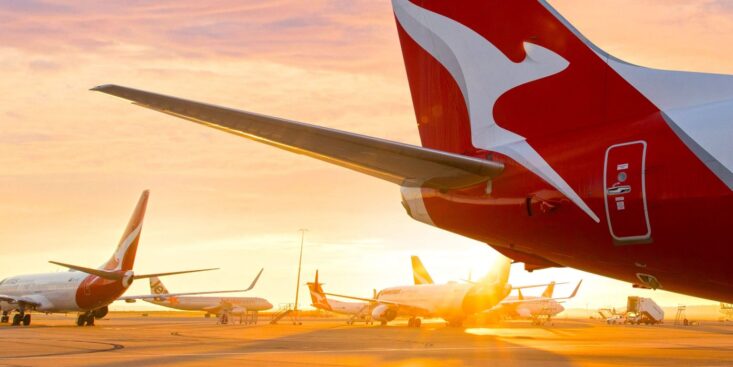Looking past Qantas, to Aviation Green Shoot
If anyone was thinking that recovery from the Covid-19 economic downturn would be quick and perfectly V-shaped, Qantas certainly had news for them, with its commentary around its recovery plan and $1.9 billion capital raising.
“It will take years before international flying returns to what it was,” said CEO Alan Joyce.
Qantas foresees flying to only half of its international capacity in FY22. It is grounding most of the international fleet – up to 100 planes.
Fortunately for Qantas, the domestic business – which generates almost two-thirds of earnings – should recover faster. The airline cut domestic capacity back to a bare-bones 5% until the middle of this month, but has since returned that figure to 15% on the crucial Sydney-Melbourne route. It expects domestic demand to fully recover in FY22, which leaves FY21 very uncertain. (The airline says its services to the resources sector has been built back up to 75% of pre-COVID levels.)
Apart from some repatriation flights underwritten by the federal government, international capacity is cancelled until at least late October.
Qantas Loyalty is expected to make the largest contribution to the FY20 result, despite a 5%-10% reduction in the division’s underlying earnings before interest and tax (EBIT) as a result of the impact of COVID-19 on travel-related products and credit-card spending. The Loyalty division usually contributes 20% of underlying earnings.
In other words, Qantas will post a loss in FY20, and probably again in FY21.
The airline has put up a lot of detail about its recovery plan, but choose your clich̩ Рis estimating earnings and profitability a stab in the dark, or pinning the tail on the donkey?
How can anyone be sure that the domestic business will recover to that extent? Will the corporate “road warriors” exhaustedly nursing their beers at the Qantas Club bars at 7 PM really want to do all the trips they used to do? Won’t more want to do more of their trips via Zoom, where they can, and have those 7 PM drinks at home? $19 flights might lure more holidaymakers to board flights, but if there has been a major shift in corporate travellers’ willingness to put in the time schlepping between offices for face-to-face meetings they now know they can do online, the airline might not get back to what it feels is normal demand.
This is true of all industries. The economic damage and the change of behaviours is real, the market remains complacent about the recovery and the ongoing risks, and may well need a reset of expectations.
Qantas’ home truths come as Victoria’s rising coronavirus infection rates remind us that what we thought was a recovery proceeding smoothly is far from it.
For the many Australians who thought overseas travel was normal, it’s at least a couple of years before the world is likely to be able to return to “normal” – and even that is not assured. And of course, it’s not just overseas travel. Quite possibly, the country is going to have millions of unemployed and under-employed people for longer than it thought, and most businesses are going to have to operate below capacity, or with much lower demand, for longer than they thought.
Investors are having to modify their way of thinking, to look for the shoots of green that can be seen through the charred ground.
In aviation, for example, instead of Qantas, it might be worth looking at contract and charter flights operator Alliance Aviation (in which Qantas has held a 19.9% stake since 2018.) In a market where being able to maintain – and not withdraw – profit guidance has been an excellent outcome, in May Alliance actually guided to pre-tax profit in FY20 of more than $40 million, almost 50% higher than forecasts in the market, and a big step-up on the $32.8 million pre-tax profit it earned in FY19, which was a record.
Earlier this month Alliance launched a $122 million capital raising to capitalise on “a number of prospective expansion opportunities’ – the company plans to buy 20 to 25 new planes, which would expand its fleet by about half, as it aims to grow its share of the Australian charter market, particularly in the “fly-in, fly-out” contract work for the resources sector. (The airline tends to get “sticky” work in this field: the average contract life over Alliance’s history is 12.1 years.) The state of the global airline market means that Alliance should be able to get these new aircraft on highly favourable terms.
Also, Alliance was recently chosen ahead of larger airlines to operate flights subsidised by the Queensland government, between Brisbane and the Whitsundays. While its tourism business has suffered – contracted inbound tourism services have been suspended and are not expected to return to normal levels until at least FY22 – Alliance has seen both an increase in the flight schedules of existing contracted clients, and the addition of new resource sector customers. The company sees the opportunity to increase contracted revenue to 75%-80% of its revenue.
It has also seen a substantial increase in demand for charter operations on the back of COVID-19 outbreak, driven by a combination of social distancing requirements and lack of availability of scheduled flights by other operators.
There are not many companies with good stories to tell in the world of COVID-16, but Alliance Aviation appears to be one of them.
On FN Arena’s consensus numbers, analysts expect profit growth in FY20, although a dividend fall given that there was no interim dividend. Against a current share price of $3 for AQZ, FN Arena’s collation has an analysts’ consensus price target of $3.725, while Thomson Reuters has $3.58.











